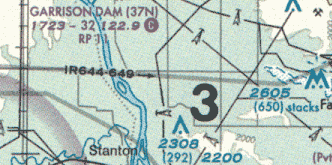FAAの筆記試験(Knowledge Exam)について。 : Privateの筆記試験について : PVTの問題へ : IFR、筆記の解説 : IFR問題へ
2008-09 Private Pilot Knowledge (Private Written) Exam 米国自家用操縦士筆記試験
111. PLT161
The lateral dimensions of Class D airspace are based on
A) the number of airports that lie within the Class D airspace.
B) 5 statute miles from the geographical center of the primary airport.
C) the instrument procedures for which the controlled airspace is established.
112. PLT064
(Refer to figure 23, area 3.) The vertical limits of that portion of Class E airspace designated as a
Federal Airway over Magee Airport are
A) 1,200 feet AGL to 17,999 feet MSL.
B) 700 feet MSL to 12,500 feet MSL.
C) 7,500 feet MSL to 17,999 feet MSL.

113. PLT064
(Refer to figure 22, area 3.) What type military flight operations should a pilot expect along IR 644?
A) IFR training flights above 1,500 feet AGL at speeds in excess of 250 knots.
B) VFR training flights above 1,500 feet AGL at speeds less than 250 knots.
C) Instrument training flights below 1,500 feet AGL at speeds in excess of 150 knots.

114. PLT194
An ATC radar facility issues the following advisory to a pilot flying on a heading of 090°:
'TRAFFIC 3 O'CLOCK, 2 MILES, WESTBOUND...'
Where should the pilot look for this traffic?
A) East.
B) South.
C) West.
115. PLT444
Responsibility for collision avoidance in an alert area rests with
A) the controlling agency.
B) all pilots.
C) Air Traffic Control.
116. PLT393
(Refer to figure 27, area 2.) What hazards to aircraft may exist in areas, such as Devils Lake East
MOA?
A) Unusual, often invisible, hazards to aircraft, such as artillery firing, aerial gunnery, or guided
missiles.
B) Military training activities that necessitate acrobatic or abrupt flight maneuvers.
C) High volume of pilot training or an unusual type of aerial activity.
117. PLT064
(Refer to figure 21 area 4.) What hazards to aircraft may exist in restricted areas such as R-5302B?
A) Unusual, often invisible, hazards such as aerial gunnery or guided missiles.
B) Military training activities that necessitate acrobatic or abrupt flight maneuvers.
C) High volume of pilot training or an unusual type of aerial activity.

118. PLT376
(Refer to figure 27, area 3.) When flying over Arrowwood National Wildlife Refuge, a pilot should fly
no lower than
A) 2,000 feet AGL.
B) 2,500 feet AGL.
C) 3,000 feet AGL.

119. PLT161
(Refer to figure 27, area 1.) Identify the airspace over Lowe Airport.
A) Class G airspace - surface up to but not including 18,000 feet MSL.
B) Class G airspace - surface up to but not including 700 feet MSL, Class E airspace - 700 feet to
14,500 feet MSL.
C) Class G airspace - surface up to but not including 1,200 feet AGL, Class E airspace - 1,200 feet
AGL up to but not including 18,000 feet MSL.
120. PLT123
After takeoff, which airspeed would the pilot use to gain the most altitude in a given period of time?
A) VY
B) VX
C) VA
Private Pilot Knowledge Test (Private Written Exam) 2008年09月18日より出題
問題が削除されただけなので、CFI Japanでは大きく変わるまで3月分を中心に和訳と解説を続けます。